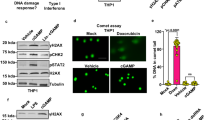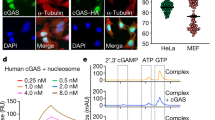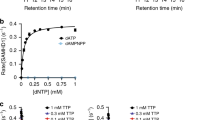Abstract
Interferons are immunomodulatory cytokines that mediate anti-pathogenic and anti-proliferative effects in cells1. Interferon-γ-inducible human guanylate binding protein 1 (hGBP1) belongs to the family of dynamin-related large GTP-binding proteins2, which share biochemical properties not found in other families of GTP-binding proteins such as nucleotide-dependent oligomerization and fast cooperative GTPase activity3. hGBP1 has an additional property by which it hydrolyses GTP to GMP in two consecutive cleavage reactions4,5. Here we show that the isolated amino-terminal G domain of hGBP1 retains the main enzymatic properties of the full-length protein and can cleave GDP directly. Crystal structures of the N-terminal G domain trapped at successive steps along the reaction pathway and biochemical data reveal the molecular basis for nucleotide-dependent homodimerization and cleavage of GTP. Similar to effector binding in other GTP-binding proteins, homodimerization is regulated by structural changes in the switch regions. Homodimerization generates a conformation in which an arginine finger and a serine are oriented for efficient catalysis. Positioning of the substrate for the second hydrolysis step is achieved by a change in nucleotide conformation at the ribose that keeps the guanine base interactions intact and positions the β-phosphates in the γ-phosphate-binding site.
This is a preview of subscription content, access via your institution
Access options
Subscribe to this journal
Receive 51 print issues and online access
$199.00 per year
only $3.90 per issue
Buy this article
- Purchase on Springer Link
- Instant access to full article PDF
Prices may be subject to local taxes which are calculated during checkout




Similar content being viewed by others
References
Stark, G. R., Kerr, I. M., Williams, B. R., Silverman, R. H. & Schreiber, R. D. How cells respond to interferons. Annu. Rev. Biochem. 67, 227–264 (1998)
Praefcke, G. J. & McMahon, H. T. The dynamin superfamily: universal membrane tubulation and fission molecules? Nature Rev. Mol. Cell Biol. 5, 133–147 (2004)
Prakash, B., Praefcke, G. J., Renault, L., Wittinghofer, A. & Herrmann, C. Structure of human guanylate-binding protein 1 representing a unique class of GTP-binding proteins. Nature 403, 567–571 (2000)
Schwemmle, M. & Staeheli, P. The interferon-induced 67-kDa guanylate-binding protein (hGBP1) is a GTPase that converts GTP to GMP. J. Biol. Chem. 269, 11299–11305 (1994)
Praefcke, G. J., Geyer, M., Schwemmle, M., Robert Kalbitzer, H. & Herrmann, C. Nucleotide-binding characteristics of human guanylate-binding protein 1 (hGBP1) and identification of the third GTP-binding motif. J. Mol. Biol. 292, 321–332 (1999)
Cheng, Y. S., Patterson, C. E. & Staeheli, P. Interferon-induced guanylate-binding proteins lack an N(T)KXD consensus motif and bind GMP in addition to GDP and GTP. Mol. Cell. Biol. 11, 4717–4725 (1991)
Anderson, S. L., Carton, J. M., Lou, J., Xing, L. & Rubin, B. Y. Interferon-induced guanylate binding protein-1 (GBP-1) mediates an antiviral effect against vesicular stomatitis virus and encephalomyocarditis virus. Virology 256, 8–14 (1999)
Guenzi, E. et al. The helical domain of GBP-1 mediates the inhibition of endothelial cell proliferation by inflammatory cytokines. EMBO J. 20, 5568–5577 (2001)
Guenzi, E. et al. The guanylate binding protein-1 GTPase controls the invasive and angiogenic capability of endothelial cells through inhibition of MMP-1 expression. EMBO J. 22, 3772–3782 (2003)
Neun, R., Richter, M. F., Staeheli, P. & Schwemmle, M. GTPase properties of the interferon-induced human guanylate-binding protein 2. FEBS Lett. 390, 69–72 (1996)
Prakash, B., Renault, L., Praefcke, G. J., Herrmann, C. & Wittinghofer, A. Triphosphate structure of guanylate-binding protein 1 and implications for nucleotide binding and GTPase mechanism. EMBO J. 19, 4555–4564 (2000)
Niemann, H. H., Knetsch, M. L., Scherer, A., Manstein, D. J. & Kull, F. J. Crystal structure of a dynamin GTPase domain in both nucleotide-free and GDP-bound forms. EMBO J. 20, 5813–5821 (2001)
Sever, S., Muhlberg, A. B. & Schmid, S. L. Impairment of dynamin's GAP domain stimulates receptor-mediated endocytosis. Nature 398, 481–486 (1999)
Marks, B. et al. GTPase activity of dynamin and resulting conformation change are essential for endocytosis. Nature 410, 231–235 (2001)
Praefcke, G. J. et al. Identification of residues in the human guanylate-binding protein 1 critical for nucleotide binding and cooperative GTP hydrolysis. J. Mol. Biol. 344, 257–269 (2004)
Scheffzek, K. et al. The Ras–RasGAP complex: structural basis for GTPase activation and its loss in oncogenic Ras mutants. Science 277, 333–338 (1997)
Uthaiah, R. C., Praefcke, G. J., Howard, J. C. & Herrmann, C. IIGP1, an interferon-γ-inducible 47-kDa GTPase of the mouse, showing cooperative enzymatic activity and GTP-dependent multimerization. J. Biol. Chem. 278, 29336–29343 (2003)
Ghosh, A., Uthaiah, R., Howard, J., Herrmann, C. & Wolf, E. Crystal structure of IIGP1: a paradigm for interferon-inducible p47 resistance GTPases. Mol. Cell 15, 727–739 (2004)
Scheffzek, K., Ahmadian, M. R. & Wittinghofer, A. GTPase-activating proteins: helping hands to complement an active site. Trends Biochem. Sci. 23, 257–262 (1998)
Modiano, N., Lu, Y. E. & Cresswell, P. Golgi targeting of human guanylate-binding protein-1 requires nucleotide binding, isoprenylation, and an IFN-γ-inducible cofactor. Proc. Natl Acad. Sci. USA 102, 8680–8685 (2005)
John, J. et al. Kinetics of interaction of nucleotides with nucleotide-free H-ras p21. Biochemistry 29, 6058–6065 (1990)
Sun, Y. J. et al. Crystal structure of pea Toc34, a novel GTPase of the chloroplast protein translocon. Nature Struct. Biol. 9, 95–100 (2002)
Focia, P. J., Shepotinovskaya, I. V., Seidler, J. A. & Freymann, D. M. Heterodimeric GTPase core of the SRP targeting complex. Science 303, 373–377 (2004)
Egea, P. F. et al. Substrate twinning activates the signal recognition particle and its receptor. Nature 427, 215–221 (2004)
Zhu, P. P. et al. Cellular localization, oligomerization, and membrane association of the hereditary spastic paraplegia 3A (SPG3A) protein atlastin. J. Biol. Chem. 278, 49063–49071 (2003)
Lavie, A. et al. Crystal structure of yeast thymidylate kinase complexed with the bisubstrate inhibitor P1-(5′-adenosyl) P5-(5′-thymidyl) pentaphosphate (TP5A) at 2.0 Å resolution: implications for catalysis and AZT activation. Biochemistry 37, 3677–3686 (1998)
Leipe, D. D., Koonin, E. V. & Aravind, L. Evolution and classification of P-loop kinases and related proteins. J. Mol. Biol. 333, 781–815 (2003)
Fisher, A. J. et al. X-ray structures of the myosin motor domain of Dictyostelium discoideum complexed with MgADP.BeFx and MgADP.AlF4 . Biochemistry 34, 8960–8972 (1995)
Song, B. D., Leonard, M. & Schmid, S. L. Dynamin GTPase domain mutants that differentially affect GTP binding, GTP hydrolysis, and clathrin-mediated endocytosis. J. Biol. Chem. 279, 40431–40436 (2004)
The CCP4 suite: programs for protein crystallography . Acta Crystallogr. D 50, 760–763 (1994)
Acknowledgements
We thank the ESRF for providing synchrotron radiation facilities and the staff of beamlines BM30A and ID14-EH1/4 for technical assistance during data collection; and E. Wolf for discussions, and M.-F. Carlier and J. Cherfils for support. This work was supported by grants from the Association pour la Recherche contre le Cancer (to L.R.) and the Boehringer Ingelheim Fonds (to G.J.K.P.).
Author information
Authors and Affiliations
Corresponding authors
Ethics declarations
Competing interests
Coordinates and structure factors have been deposited in the Protein Data Bank under accession numbers 2BC9 (GppNHp-bound hGBP1LG), 2B92 (GDP•AlF3-bound hGBP1LG), 2B8W (GMP•AlF4--bound hGBPLG) and 2D4H (GMP-bound hGBP1LG). Reprints and permissions information is available at npg.nature.com/reprintsandpermissions. The authors declare no competing financial interests.
Supplementary information
Supplementary Notes
The file contains Supplementary Methods, Supplementary Table 1 (nucleotide binding and GTP hydrolysis data), Supplementary Table 2 (nucleotide-dependent oligomerization states for both full-length hGBP1 (hGBP1FL) and LG domain of hGBP1 (hGBP1LG), Supplementary Table 3 (torsion angles of the ribose moiety in hGBP1, Ras and dynamin structures) and Supplementary Figure Legends. (DOC 180 kb)
Supplementary Figure 1
Nucleotide binding and nucleotide-dependent oligomerization experiments of hGBP1LG. (PDF 10145 kb)
Supplementary Figure 2
Sequence alignment of LG domains of human GBP homologues with residues involved in the hGBP1LG dimer interface and important mutated residues indicated. (PDF 118 kb)
Supplementary Figure 3
Schematic view of the interactions for the active site of hGBP1LG in complexes with GppNHp•Mg2+, GDP•AlF3•Mg2+, GMP•AlF4-•Mg2+ and GMP. (PDF 7963 kb)
Supplementary Figure 4
Conformational changes of switch 1, 2 and guanine cap regions between dimeric hGBP1LG•GMP•AlF4- and monomeric hGBP1LG•GMP crystal structures. (PDF 7205 kb)
Supplementary Figure 5
Schematic drawing of the consecutive events during GTP binding, GTPase-, GDPase reaction, product release and dissociation, with the corresponding structural changes as discussed in the text. (PDF 3749 kb)
Supplementary Figure 6
Views of electron density simulated-annealing omit maps around the nucleotide binding site for hGBP1LG•GppNHp, hGBP1LG•GDP•AlF3, hGBP1LG•GMP•AlF4- and hGBP1LG•GMP crystal structures. (PDF 8395 kb)
Rights and permissions
About this article
Cite this article
Ghosh, A., Praefcke, G., Renault, L. et al. How guanylate-binding proteins achieve assembly-stimulated processive cleavage of GTP to GMP. Nature 440, 101–104 (2006). https://doi.org/10.1038/nature04510
Received:
Accepted:
Issue Date:
DOI: https://doi.org/10.1038/nature04510
This article is cited by
-
Domain motions, dimerization, and membrane interactions of the murine guanylate binding protein 2
Scientific Reports (2023)
-
Importance of clitellar tissue in the regeneration ability of earthworm Eudrilus eugeniae
Functional & Integrative Genomics (2022)
-
When human guanylate-binding proteins meet viral infections
Journal of Biomedical Science (2021)
-
Substrate-binding destabilizes the hydrophobic cluster to relieve the autoinhibition of bacterial ubiquitin ligase IpaH9.8
Communications Biology (2020)
-
A Molecular Perspective on Mitochondrial Membrane Fusion: From the Key Players to Oligomerization and Tethering of Mitofusin
The Journal of Membrane Biology (2019)
Comments
By submitting a comment you agree to abide by our Terms and Community Guidelines. If you find something abusive or that does not comply with our terms or guidelines please flag it as inappropriate.



